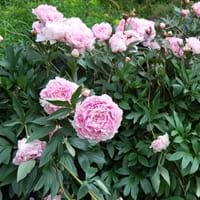Life Span
Perennial
Perennial
Type
Flowering Plants, Shrubs
Flowering Plants, Shrubs
Origin
Asia, North America, Southern Europe
Africa, America, Asia
Types
Aristocrat, Buckeye Belle, Henry Bockstoce , Abalone Pearl, Coral Supreme, Cytherea, Charlie's White
Lockinch, Petite Indigo, White Profusion
Habitat
Hillside, Woods
Along Railroads, River side, Roadsides
USDA Hardiness Zone
3-9
5-10
Sunset Zone
A3, 1a, 1b, 2a, 2b, 3a, 3b, 4, 5, 6, 7, 8, 9, 10, 11, 12, 13, 14, 15, 16, 17, 18, 19, 20, 22
H1, 2a, 2b, 3a, 3b, 4, 5, 6, 7, 8, 9, 10, 11, 12, 13, 14, 15, 16, 17, 18, 19, 20, 21, 22, 23, 24
Habit
Clump-Forming
Arching/Fountain-shaped
Flower Color
Pink, Red, White
Blue, Pink, Purple, Red, White
Flower Color Modifier
Not Available
Not Available
Fruit Color
Not Available
Not Available
Leaf Color in Spring
Dark Green
Gray Green
Leaf Color in Summer
Dark Green, Green
Gray Green, Light Green
Leaf Color in Fall
Bronze, Dark Green, Green
Gray Green, Light Green, Yellow green
Leaf Color in Winter
Not Available
Not Available
Leaf Shape
Compound
Egg-shaped
Plant Season
Spring
Fall, Spring, Summer, Winter
Sunlight
Full Sun, Part sun
Full Sun, Part sun, Partial shade
Type of Soil
Loamy
Loamy, Sandy, Well drained
The pH of Soil
Neutral
Neutral, Slightly Acidic, Slightly Alkaline
Soil Drainage
Well drained
Well drained
Bloom Time
Spring, Summer
Spring
Tolerances
Not Available
Drought, Pollution, Salt, Soil Compaction
Where to Plant?
Ground, Pot
Ground, Pot
How to Plant?
Grafting, Seedlings, Stem Planting, Transplanting
Seedlings, Stem Planting, Transplanting
Plant Maintenance
Medium
Medium
Watering Requirements
Does not require lot of watering, It cannot sustain wet-feet, Keep the ground moist but not water-logged, Needs watering once a week, Prefer drip-irrigation instead of Over-head watering, Water occasionally
Form a Soil ring to water efficiently, Water Deeply, Water twice a day in the initial period
In Summer
Lots of watering
Lots of watering
In Spring
Moderate
Moderate
In Winter
Average Water
Average Water
Soil pH
Neutral
Neutral, Slightly Acidic, Slightly Alkaline
Soil Type
Loamy
Loamy, Sandy, Well drained
Soil Drainage Capacity
Well drained
Well drained
Sun Exposure
Full Sun, Part sun
Full Sun, Part sun, Partial shade
Pruning
Do not prune during shooting season, Prune to control growth, Remove dead or diseased plant parts, Remove deadheads
Cut or pinch the stems, Prune for shortening long shoots, Prune if you want to improve plant shape, Prune ocassionally, Remove damaged leaves, Remove dead or diseased plant parts, Remove deadheads, Remove shoots
Fertilizers
All-Purpose Liquid Fertilizer
All-Purpose Liquid Fertilizer
Pests and Diseases
Botrytis Blight, Leaf spot, Stem spot, Viruses
Downy mildew, Leaf spot, Spider mites
Plant Tolerance
Drought
Drought
Flower Petal Number
Semi-Double
Single
Foliage Texture
Coarse
Medium
Foliage Sheen
Glossy
Matte
Attracts
Ants
Butterflies, Hummingbirds
Allergy
Not Available
Vomiting
Aesthetic Uses
Beautification, Bouquets, Showy Purposes, Used for decorating walls, fences, gates, hedges, etc.
Showy Purposes
Beauty Benefits
Not Available
Not Available
Environmental Uses
Air purification
Air purification
Medicinal Uses
Cough, Gout, Headache, Heartburn, Kidney problems, Upset stomach, Urinary tract problems
Not Available
Part of Plant Used
Flowers, Root, Seeds
Flowers, Leaves
Other Uses
Showy Purposes, Used as Ornamental plant, Used for fragrance
Showy Purposes, Used as Ornamental plant
Used As Indoor Plant
No
No
Used As Outdoor Plant
Yes
Yes
Garden Design
Feature Plant, Foundation, Mixed Border
Edging, Feature Plant, Foundation
Botanical Name
Paeonia lactiflora
Buddleia davidii
Common Name
Herbaceous Peony
Butterfly Bush, Summer Lilac, Butterflybush
In Hindi
Herbaceous peony
Butterfly Bush
In German
Krautige Pfingstrose
Schmetterlingsstrauch
In French
pivoines herbacées
buisson de papillon
In Spanish
peonía herbáceas
arbusto de las mariposas
In Greek
ποώδη παιωνία
Butterfly Μπους
In Portuguese
peônia herbáceas
arbusto de borboleta
In Polish
piwonii zielnych
Butterfly Bush
In Latin
herbaceum AGLAOPHOTIS
papilio rubo
Phylum
Magnoliophyta
Spermatophyta
Class
Magnoliopsida
Dicotyledonae
Order
Not Available
Lamiales
Family
Paeoniaceae
Scrophulariaceae
Clade
Angiosperms, Core eudicots, Eudicots
Angiosperms, Asterids, Eudicots
Tribe
Not Available
Not Available
Subfamily
Not Available
Not Available
Season and Care of Chinese Peony and Butterfly Bush
Season and care of Chinese Peony and Butterfly Bush is important to know. While considering everything about Chinese Peony and Butterfly Bush Care, growing season is an essential factor. Chinese Peony season is Spring and Butterfly Bush season is Spring. The type of soil for Chinese Peony is Loamy and for Butterfly Bush is Loamy, Sandy, Well drained while the PH of soil for Chinese Peony is Neutral and for Butterfly Bush is Neutral, Slightly Acidic, Slightly Alkaline.
Chinese Peony and Butterfly Bush Physical Information
Chinese Peony and Butterfly Bush physical information is very important for comparison. Chinese Peony height is 76.00 cm and width 76.00 cm whereas Butterfly Bush height is 7.50 cm and width 4.00 cm. The color specification of Chinese Peony and Butterfly Bush are as follows:
Chinese Peony flower color: Pink, Red and White
Chinese Peony leaf color: Dark Green
Butterfly Bush flower color: Blue, Pink, Purple, Red and White
- Butterfly Bush leaf color: Gray Green
Care of Chinese Peony and Butterfly Bush
Care of Chinese Peony and Butterfly Bush include pruning, fertilizers, watering etc. Chinese Peony pruning is done Do not prune during shooting season, Prune to control growth, Remove dead or diseased plant parts and Remove deadheads and Butterfly Bush pruning is done Cut or pinch the stems, Prune for shortening long shoots, Prune if you want to improve plant shape, Prune ocassionally, Remove damaged leaves, Remove dead or diseased plant parts, Remove deadheads and Remove shoots. In summer Chinese Peony needs Lots of watering and in winter, it needs Average Water. Whereas, in summer Butterfly Bush needs Lots of watering and in winter, it needs Average Water.





